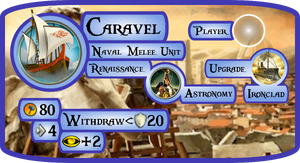
The Fan-Made Info Card featuring the Caravel Unit (Civ5)
Game Info
Fast Renaissance Era naval melee unit. Upgrades from the Trireme.
- Common abilities:
- Extra Sight (1)
- Withdraw Before Melee (Unit may withdraw when faced with melee attack)
Strategy
In the early Renaissance Era naval and orientation technology finally develop enough to allow vessels to enter open ocean. The Caravel is the first naval unit in the game capable of doing that. Depending entirely on sails, this vessel is much more stable and compact and is ideal for exploration, thanks to its larger sight radius (which, unfortunately, doesn't carry over when the unit is upgraded). The Caravel ushers in the era of geographic discoveries, allowing you to finally explore and make contact with the rest of the world.
Caravels are primarily meant for exploration, not battle; they're armed with short-range cannons which make them a melee naval unit, slightly more powerful than a Galleass. Their maneuverability allows them to retreat before enemies attacking in melee.
The importance of exploration in Civilization can't be stressed enough: it allows you to discover new lands to settle, it gives you tons of new trade opportunities as you encounter other civilizations and city-states, and it finally gives you a complete picture of the state of the world. With its large sight radius, its relatively high strength, and a special promotion that allows it to evade enemy melee attacks, the Caravel is perfectly suited for exploring and revealing as much of the map as possible while staying out of danger.
Finally, you can use Caravels to attack and take cities (although there is another Renaissance Era unit - the Privateer - that is better suited for those purposes). Still, remember that its combat strength is usually not enough for major battles, especially against later Renaissance Era ships.
Civilopedia entry
The caravel was a small, seagoing vessel used in the 15th century to explore the world. Originally created at the order of Prince Henry the Navigator of Portugal, other nations were quick to spot the caravel's qualities and created their own copies of the useful craft. Usually of some 20 to 30 yards in length and sporting two or three lateen-rigged masts, caravels were light and shallow-drafted, making them perfect for exploration of unknown coasts and rivers, boldly going where bigger craft feared to sail. They were also remarkably seaworthy ships and could survive the worst that the Atlantic could throw at them. Two of Christopher Columbus's three vessels - the Pinta and the Niña - were caravels (the larger Santa María was a carrack).
